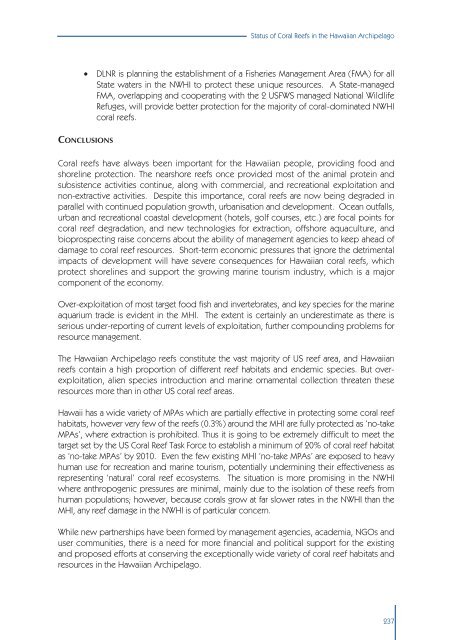Status of Coral Reefs of the World 2000
Status of Coral Reefs of the World 2000.pdf
Status of Coral Reefs of the World 2000.pdf
- No tags were found...
You also want an ePaper? Increase the reach of your titles
YUMPU automatically turns print PDFs into web optimized ePapers that Google loves.
<strong>Status</strong> <strong>of</strong> <strong>Coral</strong> <strong>Reefs</strong> in <strong>the</strong> Hawaiian Archipelago<br />
• DLNR is planning <strong>the</strong> establishment <strong>of</strong> a Fisheries Management Area (FMA) for all<br />
State waters in <strong>the</strong> NWHI to protect <strong>the</strong>se unique resources. A State-managed<br />
FMA, overlapping and cooperating with <strong>the</strong> 2 USFWS managed National Wildlife<br />
Refuges, will provide better protection for <strong>the</strong> majority <strong>of</strong> coral-dominated NWHI<br />
coral reefs.<br />
CONCLUSIONS<br />
<strong>Coral</strong> reefs have always been important for <strong>the</strong> Hawaiian people, providing food and<br />
shoreline protection. The nearshore reefs once provided most <strong>of</strong> <strong>the</strong> animal protein and<br />
subsistence activities continue, along with commercial, and recreational exploitation and<br />
non-extractive activities. Despite this importance, coral reefs are now being degraded in<br />
parallel with continued population growth, urbanisation and development. Ocean outfalls,<br />
urban and recreational coastal development (hotels, golf courses, etc.) are focal points for<br />
coral reef degradation, and new technologies for extraction, <strong>of</strong>fshore aquaculture, and<br />
bioprospecting raise concerns about <strong>the</strong> ability <strong>of</strong> management agencies to keep ahead <strong>of</strong><br />
damage to coral reef resources. Short-term economic pressures that ignore <strong>the</strong> detrimental<br />
impacts <strong>of</strong> development will have severe consequences for Hawaiian coral reefs, which<br />
protect shorelines and support <strong>the</strong> growing marine tourism industry, which is a major<br />
component <strong>of</strong> <strong>the</strong> economy.<br />
Over-exploitation <strong>of</strong> most target food fish and invertebrates, and key species for <strong>the</strong> marine<br />
aquarium trade is evident in <strong>the</strong> MHI. The extent is certainly an underestimate as <strong>the</strong>re is<br />
serious under-reporting <strong>of</strong> current levels <strong>of</strong> exploitation, fur<strong>the</strong>r compounding problems for<br />
resource management.<br />
The Hawaiian Archipelago reefs constitute <strong>the</strong> vast majority <strong>of</strong> US reef area, and Hawaiian<br />
reefs contain a high proportion <strong>of</strong> different reef habitats and endemic species. But overexploitation,<br />
alien species introduction and marine ornamental collection threaten <strong>the</strong>se<br />
resources more than in o<strong>the</strong>r US coral reef areas.<br />
Hawaii has a wide variety <strong>of</strong> MPAs which are partially effective in protecting some coral reef<br />
habitats, however very few <strong>of</strong> <strong>the</strong> reefs (0.3%) around <strong>the</strong> MHI are fully protected as ‘no-take<br />
MPAs’, where extraction is prohibited. Thus it is going to be extremely difficult to meet <strong>the</strong><br />
target set by <strong>the</strong> US <strong>Coral</strong> Reef Task Force to establish a minimum <strong>of</strong> 20% <strong>of</strong> coral reef habitat<br />
as ‘no-take MPAs’ by 2010. Even <strong>the</strong> few existing MHI ‘no-take MPAs’ are exposed to heavy<br />
human use for recreation and marine tourism, potentially undermining <strong>the</strong>ir effectiveness as<br />
representing ‘natural’ coral reef ecosystems. The situation is more promising in <strong>the</strong> NWHI<br />
where anthropogenic pressures are minimal, mainly due to <strong>the</strong> isolation <strong>of</strong> <strong>the</strong>se reefs from<br />
human populations; however, because corals grow at far slower rates in <strong>the</strong> NWHI than <strong>the</strong><br />
MHI, any reef damage in <strong>the</strong> NWHI is <strong>of</strong> particular concern.<br />
While new partnerships have been formed by management agencies, academia, NGOs and<br />
user communities, <strong>the</strong>re is a need for more financial and political support for <strong>the</strong> existing<br />
and proposed efforts at conserving <strong>the</strong> exceptionally wide variety <strong>of</strong> coral reef habitats and<br />
resources in <strong>the</strong> Hawaiian Archipelago.<br />
237
















